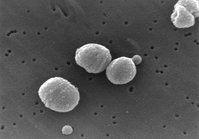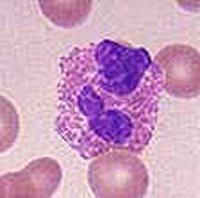Pneumonia, eosinophilic
Eosinophilic pneumonia (EP) is a disease in which a certain type of white blood cell called an eosinophil accumulates in the lung. These cells cause disruption of the normal air spaces (alveoli) where oxygen is extracted from the atmosphere. Several different kinds of eosinophilic pneumonia exist and can occur in any age group. The most common symptoms include cough, fever, difficulty breathing, and sweating at night. EP is diagnosed by a combination of characteristic symptoms, findings on a physical examination by a health provider, and the results of blood tests and x-rays. Prognosis is excellent once most EP is recognized and treatment with corticosteroids is begun. more...
Types of eosinophilic pneumonia
Eosinophilic pneumonia is divided into different categories depending upon whether a cause can be determined or not. Known causes include certain medications or environmental triggers, parasitic infections, and cancer. EP can also occur when the immune system attacks the lungs, a disease called Churg-Strauss syndrome. When a cause can not be found, the EP is labeled "idiopathic." Idiopathic EP can be divided into "acute eosinophilic pneumonia" (AEP) and "chronic eosinophilic pneumonia" (CEP) depending on the symptoms a person is experiencing.
Symptoms
Most causes of eosinophilic pneumonia have similar symptoms. Cough, fever, increasing breathlessness, and night sweats are prominent and almost universal. Acute eosinophilic pneumonia typically follows a rapid course. Fever and cough may develop only one or two weeks before difficulties breathing progress to the point of respiratory failure requiring mechanical ventilation. Chronic eosinophilic pneumonia usually follows a slower course. Symptoms accumulate over several months and include fevers, cough, breathlessness, wheezing, and weight loss. Individuals with CEP are often diagnosed with asthma before CEP is finally recognized.
EP due to medications or environmental exposures is similar and occurs after an exposure to a known offending agent. EP due to parasitic infections has a similar prodrome in addition to a host of different symptoms related to the variety of underlying parasites. EP in the setting of cancer often develops in the context of a known diagnosis of lung cancer, cervical cancer, etc.
Pathophysiology
Eosinophilic pneumonia can develop in several different ways depending on the underlying cause of the disease. Eosinophils are thought to play a central role in defending the body against infection by parasites. Many diseases, such as asthma and eczema, are caused when eosinophils overreact to environmental triggers and release an excess of chemicals (cytokines) such as histamine. The common characteristic among different causes of EP is eosinophil overreaction or dysfunction in the lung.
Medications and environmental exposures
Medications, drugs of abuse, and environmental exposures may all trigger eosinophil dysfunction. Medications such NSAIDs (ie ibuprofen), nitrofurantoin, phenytoin, L-tryptophan, and ampicillin and drugs of abuse such as inhaled heroin and cocaine may trigger an allergic response which results in EP. Chemicals such as sulfites, aluminum silicate, and cigarette smoke can cause EP when inhaled. A New York City firefighter developed EP after inhalation of dust from the World Trade Center on September 11, 2001.
Read more at Wikipedia.org



